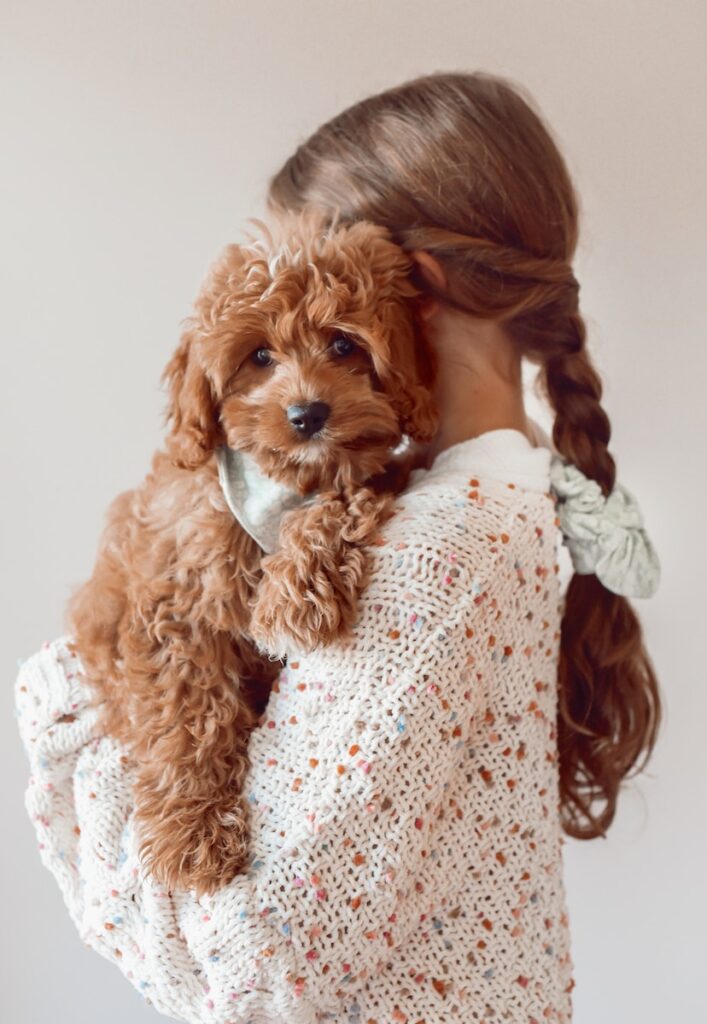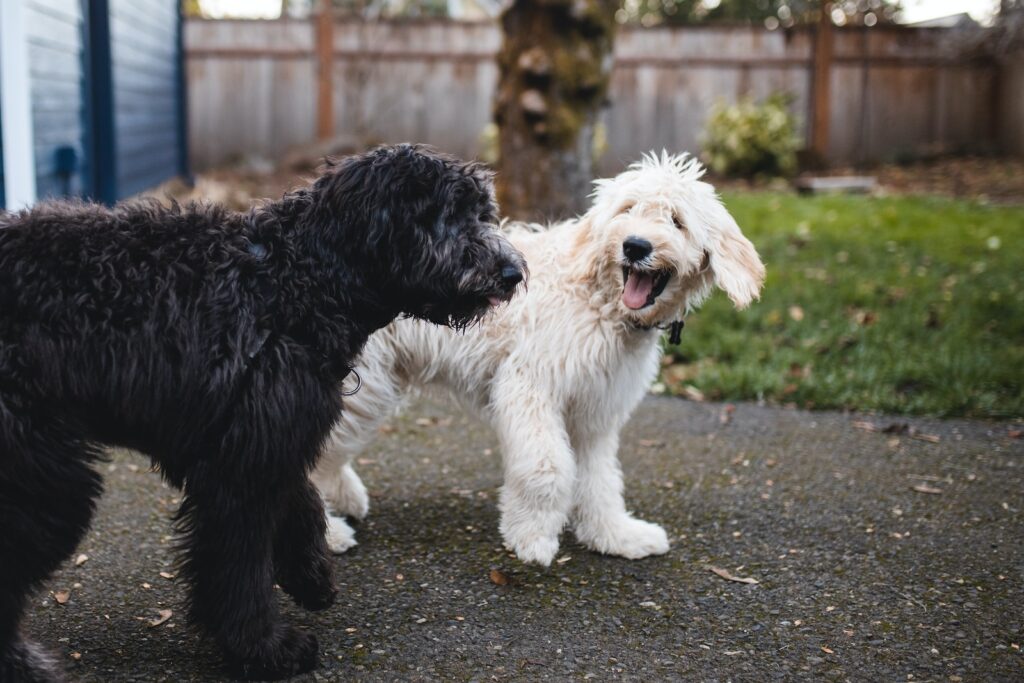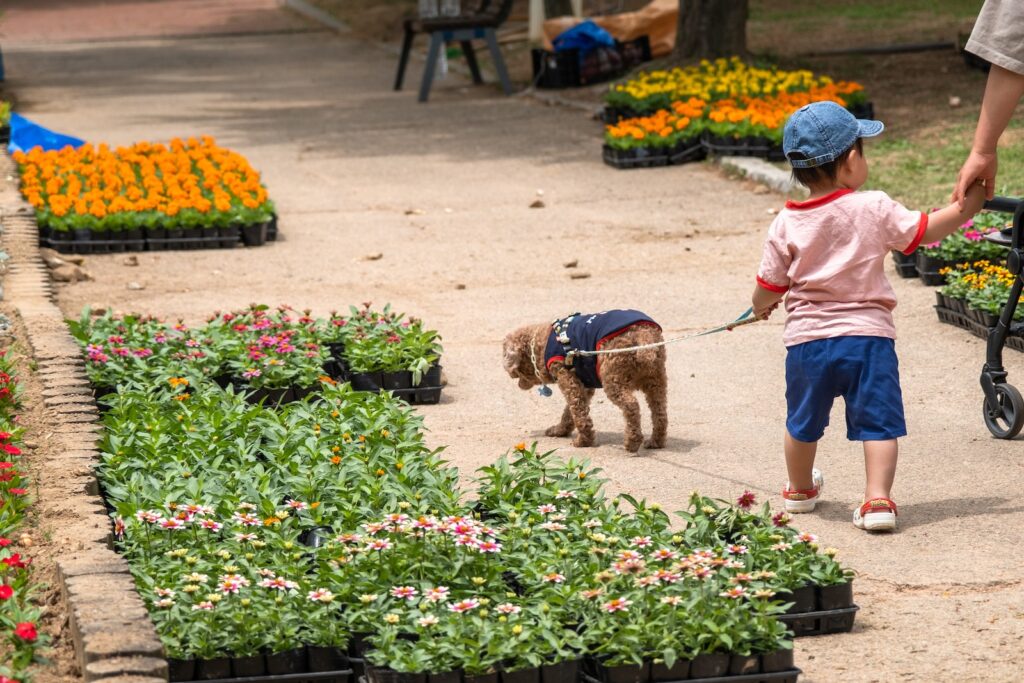Introduction: A Match Made in Heaven?
When you think of a dynamic duo, the companionship between Doodles and children likely springs to mind. Much like peanut butter and jelly, each enhances the joy and energy of the other, creating an almost magical synergy that warms the heart. However, merging this ideal partnership into a living, breathing reality isn’t as straightforward as slapping some PB&J on bread.

It involves safety protocols, emotional intelligence, and yes, even a bit of finesse in balancing the needs of both kiddos and fur-babies. From vital safety tips to innovative bonding activities, this comprehensive guide will walk you through the unique, rewarding, and at times challenging world of making dogs for kids a blissful reality. Buckle up for an exciting journey that is as enriching for you as it is for your Doodle and your children!
Table of Contents
Why Focus on Doodles?
Doodles are a popular choice for families and are often recommended as one of the best dogs for kids. Their friendly disposition, intelligence, and hypoallergenic coats make them a hit among both parents and children. But beyond these basic benefits, there’s a world of nuances to explore.
This article aims to delve deeper into how to make the Doodle-child relationship thrive, offering insights that go beyond common knowledge. You’ll find tips and strategies to ensure your home is not just a house but a harmonious haven for all its two-legged and four-legged inhabitants.
So, what should you expect as you read on? You’ll find answers to crucial questions, ingenious activity ideas, and even solutions to common problems like jealousy and age-related changes. By the end of this guide, you’ll be well-equipped to make the Doodle-kid duo in your home not just co-exist but thrive in each other’s company. And that, dear readers, is what we call a match made in heaven.
Now, without further ado, let’s take our first step into this fascinating realm where children and Doodles make life a whole lot brighter.
Chapter 1: What Makes Doodles Kid-Friendly?
Personality Traits: They Just Get Along!
Doodles are often cited among the best dogs for kids, and there’s compelling reasoning behind this. Their temperament often strikes a perfect balance, inheriting enthusiasm from their Retriever lineage and intelligence from their Poodle ancestors. These four-legged friends are usually friendly, social, and incredibly adaptable, traits that make them ideal companions for children.

But let’s dig deeper beyond the surface. Doodles have a knack for emotional intelligence. They often intuitively sync with a child’s emotional state—becoming playful when the child is energetic and offering cuddles when it’s downtime.
Research also supports the enriching role of dogs in children’s lives. A study published by the NCBI emphasizes the significance of childhood attachment to pets for nurturing compassion and humane behavior. Therefore, when we say Doodles are emotionally compatible with children, we’re acknowledging a bond that is multidimensional, benefiting both the pet and the child in ways more than one can easily observe.
Allergy-Friendly Coats: Achoo-Free Zone
The hypoallergenic qualities of Doodles often get a lot of attention, and rightfully so. While no dog can be deemed entirely hypoallergenic, Doodles are about as close as it gets, thanks to their Poodle parentage. This feature is a relief for families with allergy sufferers, ensuring that the home environment remains as sniffle-free as possible.
But the hypoallergenic trait of Doodles offers more than just physical comfort; it grants emotional peace of mind. Parents can rest easier knowing that their child’s loving interactions with their Doodle are less likely to lead to sneezing fits or more severe allergic reactions. The fewer health concerns to worry about, the more space there is for those heartfelt moments that make both childhood and dog companionship such rewarding experiences.
Chapter 2: Preparing for the Introduction
Setting Boundaries: Not Just a Physical Fence
Creating a safe environment for your child and your Doodle to coexist starts with establishing boundaries. While articles like the one from Rover offer valuable tips on this, there’s more to explore in the realm of setting boundaries.
It’s not just about the physical interactions between dogs and kids; it’s also about shaping their social and emotional exchanges. For instance, teaching children the signs of canine discomfort, such as yawning or turning away, can help them better understand their Doodle’s emotional boundaries.

The process of setting boundaries also offers an invaluable lesson in mutual respect. This is where children learn to recognize a Doodle as not just a playmate but a sentient being with needs and preferences. They learn to pay attention to the dog’s body language and adapt their behavior accordingly. Likewise, training your Doodle to follow certain commands can establish boundaries for the dog, reinforcing a sense of order that both parties can understand.
The First Meet: Nailing the First Impression
First impressions are the foundation of any relationship, and that holds true for Doodles and children. The introduction should be a calm and positive experience for both. A poorly managed first meeting can set the tone for a relationship fraught with misunderstandings and insecurities.
Beyond the standard advice of keeping the first meeting controlled and supervised, consider utilizing “scent handshakes” to acquaint your child and Doodle before they even meet face-to-face.
A scent handshake involves taking a cloth with the scent of one party and letting the other party smell it before meeting. This strategy can help both the child and the Doodle become familiar with each other’s scent, making the first physical meeting less intimidating.
Making the first introduction positive will set the stage for a harmonious relationship, aligning well with the evidence that positive early experiences with pets can contribute to a child’s emotional well-being, as highlighted in the NCBI article.
By putting in the work initially to make the first meeting as smooth as possible, you’re laying the groundwork for a friendship that could last a lifetime, enriching both your child’s and your Doodle’s life in innumerable ways.
Chapter 3: Safety Concerns and How to Address Them
Supervised Play: Eyes on the Prize
One of the core principles of child-and-dog interaction is never to leave them unsupervised. But beyond keeping an eye on them, it’s essential to actively engage in their playtime. This is a commonly overlooked aspect of supervision that provides an extra layer of safety and enriches the interaction for both the Doodle and the child. Being an active participant allows you to correct either the dog or the child instantly if you see potentially dangerous or aggressive behavior, thereby teaching them the correct way to interact in real-time.
It’s not just about preventing harm; it’s about encouraging positive behavior. Instead of merely watching, narrate the dog’s actions for your child to understand. Phrases like, “See how Doodle is wagging his tail? That means he’s happy!” can go a long way in helping your child understand dog body language, which is a vital aspect of their long-term safety.
Teaching Empathy and Respect: It’s a Two-Way Street
While safety is often the focal point, fostering emotional intelligence through pet ownership is seldom discussed. However, this is paramount in creating a harmonious home environment. Children need to learn not just the dos and don’ts of interacting with their furry friends, but also the ‘whys’ behind them.
For example, explain that pulling a dog’s tail can hurt the dog, teaching them that their actions have consequences on the feelings and well-being of others.
This also sets the foundation for a more advanced understanding of empathy and compassion. Children need to realize that their Doodle has its own set of feelings, desires, and fears. Encourage children to view things from the dog’s perspective. Prompt them with questions like, “How do you think Doodle feels when you do that?” This not only fosters empathy but can also reduce instances of accidental harm or distress to the dog.
By focusing on mutual respect and empathy, you’re ensuring a more peaceful and fulfilling relationship between your child and their Doodle, while also setting your child up for positive relationships with animals and humans alike as they grow.
Chapter 4: Bonding Activities for Doodles and Kids
Fetch: The Classic Game
Fetch is more than just a game; it’s an educational experience when you approach it the right way. While this game helps both the child and the Doodle burn energy, it also offers a unique opportunity to instill lessons of patience, turn-taking, and mutual respect.
Instruct your child to wait for the Doodle to drop the ball before throwing it again, emphasizing the importance of respecting the dog’s pace and comfort level. Switch roles sometimes: let your child be the ‘fetcher,’ and instruct the Doodle to “drop” the ball, introducing them to the concept of role reversal and empathy.
Moreover, always consider safety first by choosing a ball that isn’t too small to be a choking hazard for your Doodle or too large for your child to handle comfortably. The size of the fetch toy can make a significant impact on the safety and enjoyment of the game for both parties.
Art and Craft: Paw Painting
Now, here’s a bonding activity that is often overlooked: Paw Painting. It’s an unorthodox yet incredibly enriching experience for both kids and Doodles. However, this isn’t just a messy free-for-all. Use this activity to teach your child about color recognition and improve their motor skills while simultaneously creating a lifelong keepsake featuring your Doodle’s paw prints.
Ensure you’re using pet-safe, non-toxic paint for this activity. Once the art project is done, take the opportunity to turn it into a learning experience. Ask your child to wash the Doodle’s paws, teaching them about the importance of cleanliness for everyone, four-legged family members included.
By engaging in activities that are not only fun but also educational, you’re enhancing the quality of life for both your child and your Doodle. These shared experiences will be the building blocks of a robust and fulfilling relationship for years to come.
Chapter 5: Navigating Challenges
Jealousy: The Green-Eyed Monster
Jealousy can rear its ugly head in any relationship, and the dynamic between your child and Doodle is no exception. Often, we view jealousy as a petty emotion, but in reality, it can serve as an indicator of underlying issues like neglect or insecurity.
Addressing jealousy requires a nuanced approach that validates both your child’s and your Doodle’s need for attention. Allocate one-on-one time with each, creating ‘Special Days’ where your child gets extra playtime and a ‘Doggy Day’ where your Doodle gets an extended walk or an extra treat.
The idea here is to foster individual relationships without sparking envy. Explain to your child that love isn’t a finite resource and that caring for their Doodle doesn’t diminish the love you have for them.
Similarly, use positive reinforcement to reward your Doodle when they behave well around your child, establishing that good things happen when they’re together.
Age-Related Changes: Growing Together, Not Apart
As your Doodle moves into its senior years and your child transitions through various life stages, adaptability becomes key. For instance, a senior dog might not be as tolerant of a toddler’s erratic movements, and a teenager might lose interest in the pet they adored as a child. Recognize these shifts as natural but address them proactively.
For aging Doodles, create a calm environment where they can retreat from high-energy play. Equip your home with senior-dog-friendly accessories like orthopedic beds and non-slip rugs. On the child’s end, involve them in the responsibility of senior dog care, from administering medication to understanding the importance of regular vet visits.
Navigating these challenges might require you to adjust your household rules and rituals, but it’s all part and parcel of maintaining a harmonious family dynamic. With concerted effort and communication, the bond between your child and Doodle can be resilient enough to withstand the tests of time and change.
Conclusion: Making Life a ‘Fur-tastic’ Journey
Creating a seamless relationship between your Doodle and your child isn’t just a walk in the park—pardon the pun. It takes thoughtful preparation, continuous education, and lots of love. While dogs for kids often come highly recommended for their developmental benefits, the road to a harmonious relationship can have its bumps.
But don’t fret! Think of this journey like a car ride; you might hit some potholes or take a few wrong turns, but ultimately, you’re headed towards a beautiful destination filled with joy and paw prints.

One of the greatest gifts you can give your child is a pet, and Doodles, with their friendly disposition and allergy-friendly coats, often make the best companions. However, as with any relationship, maintaining peace and happiness requires work.
There’s the issue of jealousy that needs a balanced approach, the complexities of a dog aging alongside a growing child, and of course, the everyday joys and challenges of coexistence.
Referencing an article from Rover, their guide on introducing a dog to children offers sound advice on setting boundaries and ensuring safety, a must-read for anyone looking to make this important introduction.
Similarly, a study from the NCBI emphasizes the psychological and emotional benefits that come from a strong child-pet bond, something that can only be nurtured through mutual respect and understanding.
If done right, the friendship between your child and your Doodle could end up being one of the most treasured relationships of their life. And in the process, you will teach them valuable life skills such as empathy, responsibility, and the importance of unconditional love.
In the grand scheme of things, a little fur on your furniture or an occasional sibling rivalry between your child and Doodle is a small price to pay for a lifetime of shared laughter, love, and learning. Here’s to a ‘fur-tastically’ rewarding experience for your entire family! 🐾👶
FAQs
- Is it safe to leave my Doodle alone with my child?
- As a general rule of thumb, especially for dogs for kids, never leave your Doodle and child unsupervised. While Doodles are known for their friendly and calm demeanor, both animals and children are unpredictable. It’s always better to err on the side of caution to prevent any unexpected incidents. Safety first!
- My child has allergies. Is a Doodle a good choice?
- Doodles often come with hypoallergenic coats, which makes them a popular choice for families with mild allergies. However, it’s crucial to consult a healthcare provider for a more personalized assessment. Always remember that hypoallergenic doesn’t mean completely allergy-free; it simply lowers the risk of an allergic reaction.
- How do I handle jealousy issues between my Doodle and child?
- Doodles often come with hypoallergenic coats, which makes them a popular choice for families with mild allergies. However, it’s crucial to consult a healthcare provider for a more personalized assessment. Always remember that hypoallergenic doesn’t mean completely allergy-free; it simply lowers the risk of an allergic reaction.
- What activities are unsafe for Doodles and kids?
- Avoid activities that involve small objects that could be swallowed or rough play that could lead to accidental injuries. Remember that while Doodles are robust and generally good-natured, they still have their limits, and it’s essential to keep the well-being of both the child and the dog in mind.
- How do I know if my Doodle is getting enough exercise with playtime?
- Doodle Fitness: Best Dog Exercise Regimens for Energetic Doodles
- If you find your Doodle restless or displaying signs of anxiety, it could indicate a lack of exercise. Doodles are energetic by nature and require both physical and mental stimulation for a balanced life. Consult your vet for age and breed-specific recommendations to ensure you’re meeting your Doodle’s exercise needs adequately.
And there you have it! With these FAQs, you’re now better equipped to handle the ups and downs of merging a home filled with kids and Doodles. May your home be filled with the joyful sounds of giggles and wagging tails! 🐾👶

